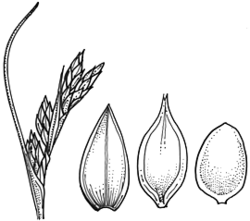Carex hebes Nelmes APNI* 
Description: Rhizome short; shoots loosely tufted. Culms erect, trigonous to subterete, occasionally scabrous above, 4–20 (rarely to 35) cm long, 0.7–1 mm diam.
Leaves usually shorter than culms; blade 1–2.5 mm wide; sheath pale brown; ligule rounded.
Inflorescence spreading, 0.5–1.2 cm long, with 2–5 spikes solitary at nodes; lowest involucral bract exceeding inflorescence. Spikes sessile, contiguous, spreading at maturity, 0.5–1.1 cm long; all spikes gynaecandrous. Glumes acute to obtuse, occasionally shortly mucronate, orange-brown, with usually broad white or hyaline margins; female glumes c. 3.5 mm long. Perigynia (utricles) ovoid to ellipsoid, weakly several-nerved, 3.2–4.5 mm long, 1.5–2 mm diam., minutely hispid on slightly winged shoulders and beak, green to pale brown; beak 0.3–0.8 mm long, with apex shortly split or 2-fid. Anthers 1.3–2.2 mm long excluding appendage c. 0.1 mm long. Style 2-fid.
Nut ellipsoid to obovoid, lenticular in cross section, typically truncate at the apex and obtuse at the base, yellow-brown.
Flowering: summer.
Distribution and occurrence: South from Brindabella Range. Also in high altitude areas in Vic. Grows in alpine and subalpine heath and grassland (drier sites).
NSW subdivisions: ST
Other Australian states: Vic.
This is very close to C. raleighii. C. hebes is generally bigger in its parts than C. raleighii, except that C. raleighii is often taller. The fruit inside the utricle is bigger in C. hebes and more or less truncate at the apex and obtuse at the base, whereas the fruit apex is more obtuse to broad-acute at the apex and more elongate at the base in C. raleighii. Fine details of the utricle also differ slightly: the wing on the neck of the utricle is slightly broader in C. hebes, and the base of the utricle is more truncate in C. hebes. However, there is not a complete correlation of characters, and further study is needed to assess whether these are two distinct species or one species that varies according to habitat.
Text by K. L. Wilson (1993); edited KL Wilson (Aug 2016, May 2018)
Taxon concept: Flora of NSW 4 (1993)
APNI* Provides a link to the Australian Plant Name Index (hosted by the Australian National Botanic Gardens) for comprehensive bibliographic data
***The AVH map option provides a detailed interactive Australia wide distribution map drawn from collections held by all major Australian herbaria participating in the Australian Virtual Herbarium project.
|


